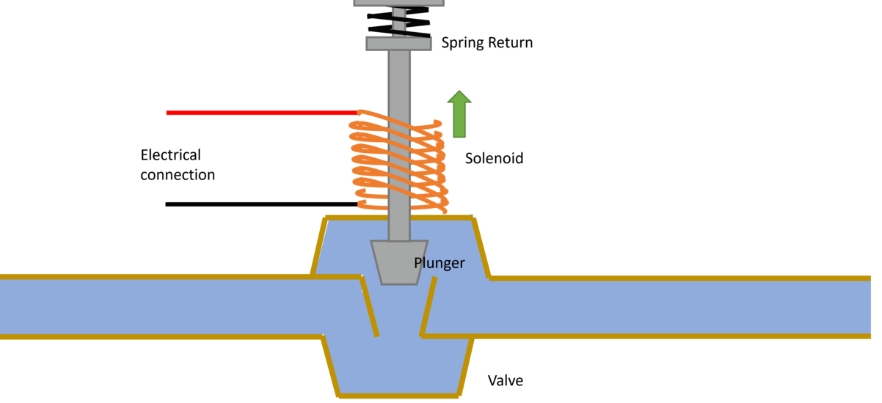What is the working principle of the solenoid valve? How to choose
A solenoid valve is an important tool. It uses electricity. It controls fluid flow. The fluid can be water. It can be air. It can be oil. The valve has a part called a solenoid. The solenoid is a coil of wire. The wire gets electricity. This creates a magnetic field. The magnetic field pulls a plunger. The plunger is a piece of metal. It moves inside the valve. This movement opens or closes the valve. So, the valve is a kind of switch. It controls the fluid. It starts the flow. It stops the flow.
The valve works fast. It can open or close in a short time. This makes it good for many jobs. It is used in many machines. It is used in many factories.
A solenoid valve and a servo motor are both used in control systems. A servo motor controls movement. It can move things to a specific position. A solenoid valve controls fluid. It can turn the fluid on or off. They often work together. A servo motor might move a part. A solenoid valve might release liquid at the same time.

How to Choose a Solenoid Valve
Choosing a solenoid valve is not hard. You must think about several things. These things will help you find the right valve. They will help you find the best solenoid valve for your job.
What Fluid Do You Use?
You must know what fluid goes through the valve. Is it water? Is it gas? Is it a chemical? Different fluids need different valves. For water, you can use a common valve. If the fluid is a chemical, you need a valve made of special materials. For example, you might need a stainless steel valve. This material will not get damaged by the fluid.
What is the Pressure and Temperature?
Every solenoid valve has a pressure rating. Your system's pressure cannot be higher than this rating. If it is, the valve can break. The valve also has a temperature rating. The fluid's temperature cannot be higher than this rating. If it is, the valve can be damaged. You must check these two numbers.
What is the Voltage?
A solenoid valve needs power. You must know your power source voltage. Valves come in AC (alternating current) and DC (direct current). Common voltages are 12V, 24V, 110V, and 220V. You must match the valve's voltage to your power source. The wrong voltage will break the valve's coil.
What Size and Connection Do You Need?
The valve has a port size. This size must match your pipe. Common sizes are 1/4 inch, 1/2 inch, and 1 inch. Also, valves have different connections. Some are threaded. Some use flanges. You must choose the right size and connection for your pipes.
Do You Need it Normally Open or Normally Closed?
Solenoid valves have two main types. One type is normally closed. It is closed when it has no power. It opens when it gets power. This is the most common type. The other type is normally open. It is open when it has no power. It closes when it gets power. You must choose the right type. If you want the fluid to stop when the power goes out, choose a normally closed valve.
Finding the Best Solenoid Valve
People often ask, "What is the best solenoid valve?" There is no single best one. The best solenoid valve is the one that fits your needs perfectly. A food factory needs a valve for water. The area is wet. The best valve for them is a waterproof, stainless steel valve. This is because it will not rust. A gas stove needs a special valve. This valve must be very safe. The best one for it is a gas-certified valve. It is certified for safety.
So, to find the best solenoid valve, you must first list your needs. You need to know your fluid, pressure, temperature, and size. When you know these things, you can find the right valve.
Where to Buy and Joydo
There are many places to buy a solenoid valve. Many people buy them online. You can find many brands there. Prices are easy to compare. Many people also buy from local stores. These stores sell industrial parts. You can see the valve there. You can ask questions.
You can also Purchase solenoid valves from Joydo. Joydo is an electronic components procurement company. They have a good reputation. It have many types of valves and good customer support. When you buy from Joydo, you can get a high-quality product. You can get technical help. This is important. It helps you choose the right product. It helps you solve problems later.
When you buy from any place, you should check a few things. You should read reviews from other people. Good reviews mean the product is good. You should also make sure the seller gives you a warranty. A warranty means they will fix or replace the valve if it breaks. This gives you peace of mind.
Solenoid Valve and Servo Motor Work Together
A solenoid valve and a servo motor are both essential components in automation, each serving a different role but complementing one another. A servo motor provides precise, controlled motion—such as positioning a robot arm at an exact location. A solenoid valve, on the other hand, enables accurate on/off fluid control, like triggering a spray of liquid at the right moment.
Consider a factory machine that fills bottles. The servo motor moves the dispensing head up and down, while the valve controls the liquid flow. As the head shifts to the next bottle, the fluid control shuts off instantly. This seamless coordination delivers both speed and accuracy—an ideal example of how these two devices work together in automation.
Conclusion
A solenoid valve is an electrically driven device that uses a coil and plunger to regulate fluid flow. Choosing the right option means matching the component to your specific needs—considering factors such as fluid type, pressure, voltage, and size. There is no single “best” choice; the ideal valve is the one that fits your application.
These products are available from many suppliers, including Joydo, who can help select the proper model. Compact yet powerful, the solenoid valve works especially well alongside servo motors, enabling many modern automation systems.









